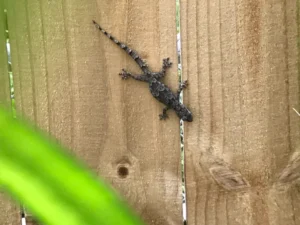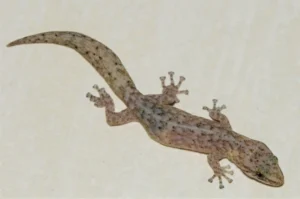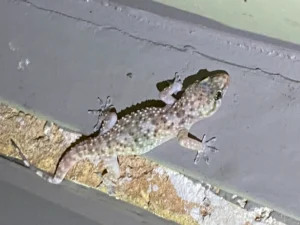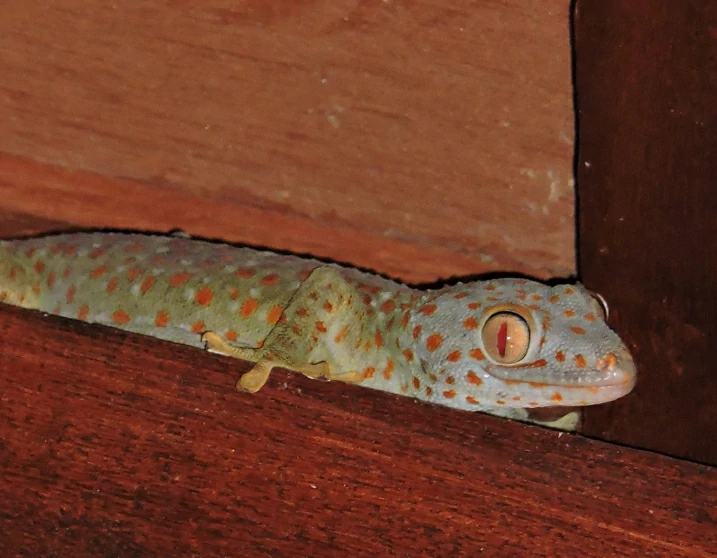You walk out onto your lanai in the evening, maybe with a drink in hand, ready to relax. Then out of the corner of your eye, you see something move.
A tiny gecko darts across the wall, pauses under a chair, and disappears. You spot another near the light, chirping softly. Before long, it feels like your lanai has turned into their hangout spot.
They’re cute in their own way, but not everyone wants lizards sharing their outdoor space. So, what can you actually do to keep geckos off your lanai without hurting them?
You can keep geckos off your lanai by reducing food sources, sealing gaps, dimming lights, and using natural repellents like garlic, coffee grounds, or essential oils.
Geckos don’t come to bother you. They come for the insects and warmth. The goal isn’t to fight them; it’s to make your lanai less attractive so they move on naturally.
Why Geckos Are Drawn to Your Lanai
Before you can keep them out, it helps to know why they’re showing up. Geckos are insect hunters. They go where mosquitoes, moths, and flies gather, and outdoor lights attract all those bugs right to your lanai.

Your lanai also gives them exactly what they want:
-
Warm surfaces that stay cozy after sunset
-
Shelter under furniture or planters
-
Moisture from potted plants or evening dew
If you live somewhere warm or tropical, geckos are just part of the local environment. But that doesn’t mean they need to take over your outdoor retreat.
How Geckos Get Onto a Lanai
Geckos are incredible climbers. Their toes are covered in thousands of microscopic hairs that let them stick to almost any surface; glass, tile, metal, even ceilings. That’s why they can crawl up your lanai screen or cling to the ceiling fan without falling.
They usually sneak in through:
-
Small gaps under screens or sliding doors
-
Cracks in walls or flooring
-
Open vents or tiny drainage holes
Even a space the width of a pencil can be enough. If you’ve ever wondered how one appeared “out of nowhere,” that’s usually how it happens.
Step 1: Make the Lanai Less Attractive to Insects
The easiest way to reduce geckos is to get rid of what they eat. If there are no bugs, the geckos will eventually move on.
-
Switch to yellow or warm-colored bulbs. Insects are drawn to bright white or blue-toned light. Yellow “bug lights” attract fewer insects, which means fewer geckos.
-
Keep food and drinks sealed. Even small crumbs or sugary drink spills can attract flies and ants. Once those insects show up, geckos follow.
-
Clean often. Wipe down tables, railings, and chair legs. A few drops of juice or soda can invite pests.
-
Remove standing water. Pet bowls, saucers under plants, or puddles from rainwater all attract insect, and then geckos.

These changes sound small, but together they make a huge difference within just a few days.
Step 2: Seal Up the Places They Hide
Once food is gone, the next reason geckos stick around is shelter. Your lanai might have plenty of small hiding spots they love.
Common hiding places include:
-
Behind outdoor cushions
-
Under storage boxes or planters
-
Inside wall corners or light fixtures
-
Along ceiling edges or decorative lights
Try rearranging furniture to reduce dark, tight spaces. Move pots a few inches from walls, and check behind wall decor. You can also use clear silicone caulk to seal small gaps and cracks, especially near lights or window frames.
It doesn’t just keep geckos out, it blocks spiders and ants too.
How to Deter Geckos Naturally
If you’d rather not use chemicals, several gentle methods can keep geckos away without harming them.
1. Garlic or onion water spray.
Crush a few garlic cloves or onion pieces, mix them with water, and spray around your lanai’s edges. The smell fades quickly for people, but geckos hate it.
2. Coffee grounds or tobacco.
Scatter used coffee grounds or dry tobacco behind pots or near corners. Geckos avoid strong odors.
3. Eggshell trick.
Leave a few dry eggshell halves around. Geckos sometimes mistake them for predator shells and stay away.
4. Essential oils.
Peppermint, citronella, and eucalyptus oils work great. Mix a few drops with water and spray lightly around the area.
5. Mothballs (use carefully).
Mothballs work too, but keep them away from kids and pets. The smell is strong, but geckos dislike it.
Natural repellents work best alongside cleanliness and lighting changes.
Do Geckos Cause Any Harm?
It’s a fair question. They might look unsettling to some people, but geckos don’t cause real harm. They don’t chew furniture, bite humans, or spread diseases.
The only minor issues are:
-
Small droppings, often near lights or walls
-
Occasional surprise visits inside homes
-
Bits of shed skin

They’re actually helpful, eating mosquitoes, moths, and roaches that might otherwise bother you. Still, it’s understandable if you’d prefer to enjoy your lanai without them darting around your chair legs.
How to Keep Geckos Away at Night
Geckos are most active after dark when insects are buzzing near the lights. If your lanai is busiest at night, these small changes help:
-
Turn off unnecessary lights after sunset.
-
Keep screen doors tightly closed.
-
Angle lights away from walls, since geckos perch there to hunt.
-
Try motion-sensor lights that only turn on when needed.
Reducing nighttime light is one of the most effective ways to discourage geckos.
Are Commercial Gecko Repellents Worth It?
You’ve probably seen sprays or ultrasonic devices that claim to scare geckos away. Some can help, but the results really vary.
Sprays: Natural citronella or lemongrass sprays can help for a few days but need reapplying, especially after rain.
Ultrasonic devices: These make a high-pitched sound meant to irritate geckos. Some people swear they work, others notice no difference at all.
If you try one, choose one that’s outdoor-rated and safe for pets. Still, the best long-term fix is removing what draws them in: food, light, and shelter.
What If Geckos Already Live on Your Lanai?
If a few have already moved in, it’s best to guide them out gently instead of scaring them.
Here’s how:
-
Open one side of the lanai to give them an escape route.
-
Tap near where they hide and gently sweep them toward the opening.
-
Don’t touch them directly. If frightened, geckos drop their tails. It’s harmless but stressful for them.
-
After they’re gone, clean surfaces with vinegar or essential oil spray to remove scent trails.
Once the space feels less inviting, they usually won’t come back.
How to Gecko-Proof Your Lanai Long-Term
Think of your lanai like a mini ecosystem. Every small habit you change makes it less friendly to geckos.
Lighting:
-
Use yellow bug bulbs.
-
Install motion sensors to reduce constant light.
Food and Bugs:
-
Keep food sealed and surfaces clean.
-
Use safe insect repellents or citronella.
Shelter:
-
Seal cracks with silicone.
-
Rearrange furniture to reduce hiding spots.
Smell Barriers:
-
Spray garlic, coffee, or essential oils.
Maintenance:
-
Check screens and door seals monthly.
-
Sweep behind planters and decor often.
All these little steps add up to one big result: a lanai geckos no longer find comfortable.
What About Baby Geckos?
If you start seeing tiny geckos, it usually means some hatched nearby. Females lay eggs in quiet corners, behind pots, or under ledges.
Here’s what to do:
-
Look for small white eggshells or old skin near walls.
-
Move furniture occasionally to uncover hidden nests.
-
Seal cracks where they might lay eggs.
Baby geckos can’t travel far, so if you remove them gently and close off those spaces, you’ll stop new ones from appearing.
Why Geckos Sometimes Keep Coming Back
Even after cleaning and sealing, a gecko or two might return. That’s normal. Geckos are creatures of habit and often check their favorite hunting spots for weeks.

Stay patient. Once they realize there’s no food or warmth, they’ll move on. You can speed things up by:
-
Keeping lights dim in the evening
-
Using natural repellents regularly
-
Keeping the lanai clean and dry
It’s less about chasing them away and more about changing what attracts them.
Do Geckos Ever Become an Infestation?
Usually not. Even in warm climates, geckos don’t breed quickly. They lay just a few eggs at a time and prefer staying outdoors.
Still, if your lanai connects to your home, it’s smart to keep them out of shared spaces. Once inside, they can leave droppings behind picture frames or curtains.
So, treating the lanai as your “first defense zone” helps protect the rest of your house too.
How to Coexist Peacefully
It’s worth remembering that geckos aren’t dirty or aggressive. They’re part of the ecosystem and, in many cultures, even symbols of good luck.
If you can reduce their presence while letting them live naturally outside, that’s the best balance. It’s less about “getting rid of geckos” and more about setting healthy boundaries.
Your lanai can stay clean, calm, and yours, while the geckos go find their bugs somewhere else.
Conclusion
Geckos show up on lanais because they find food, warmth, and light there. By changing your lighting, sealing small gaps, cleaning often, and using simple natural repellents, you can make your lanai a place they don’t want to stay.
It takes a little patience, but it works. Soon you’ll notice fewer bugs, fewer droppings, and eventually, no small shapes darting across the walls when you sit down to relax.
You don’t need to harm geckos to reclaim your space. You just need to make it a little less perfect for them, and they’ll happily move along to somewhere else.
Hi, my name is Ezra Mushala, i have been interested animals all my life. I am the main author and editor here at snakeinformer.com.

